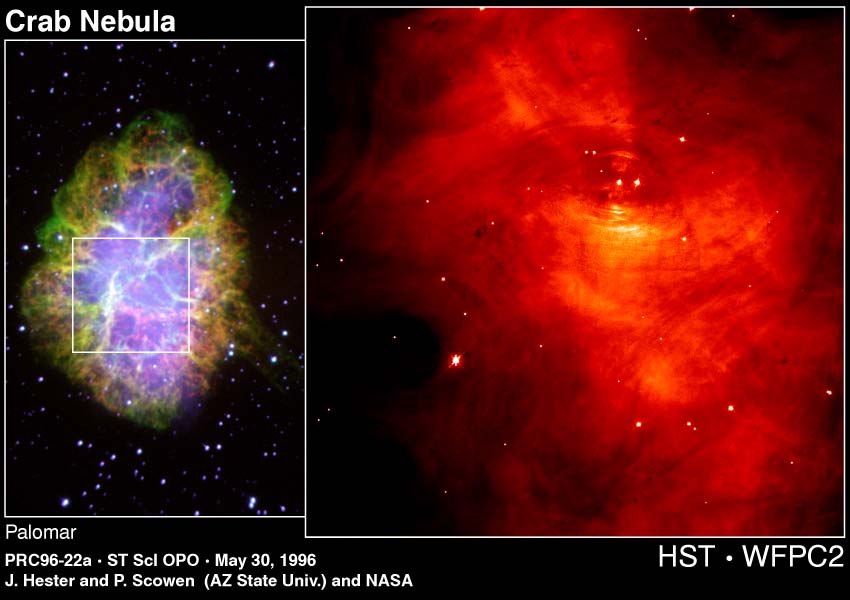What's Left After a Supernova
Nebulae/Supernova Remnants
The outer layers
of the star are propelled into space by the expanding shock wave creating
a supernova remnant, a type of nebula. This material is now available to
be recycled into another star, planet, or possibly eventually a life form
billions of years down the road. The Crab Nebulae is a good example of
a supernova remnant. It has been connected to observations by Chinese observers
of a supernova that was visible for two years in 1054 (Murdin, 13). The
shockwave and the gas it carries can compress other gas clouds in space
enough to trigger star formation. This phenomena has been observed in the
Cygnus Loop (Kaufmann & Freedman, 510).
images from STScI/NASA public info web page

Neutron Stars
The core that remains
after a supernova explosion is an extremely dense ball of neutrons. If
its mass does not exceed three solar masses it will remain a neutron star
(Begelman & Rees, 43). This remnant of the stars core is made stable
by the neutron degeneracy forces that exists because two particles that
have 1/2 unit of angular momentum, or “spin” cannot have the same position
and momentum (Begelman & Rees, 29). All particles that have 1/2
spin are called fermions, electrons, protons, and neutrons (Begelman &
Rees, 29). The core has collapsed down to nuclear density, 10^15 times
higher then the ordinary solid, thus it's size is relatively small on the
order of 10 kilometers (Begelman & Rees, 41). Because it is so
small and dense it's surface is extremely flat due to the gravitational
pull that it exerts. The composition of a neutron star is even less understood.
It's thought that the outer layer is a solid crust of nuclei and electrons.
Underneath that is a superfluid that has no viscosity and is made of free
neutrons. Little is understood about what types of particles the core may
contains (Begelman & Rees, 45).
Neutron stars besides being
dense have intense magnetic fields. The field is intensified by the
compression of the magnetic field lines in the star as the core collapses.
This creates a magnetic field about 10^9 times that of an ordinary star.
(Begelman & Rees, 46) These magnetic field lines accelerate electrons
toward the stars poles creating synchrotron radiation. This radiation ionizes
the gas in a supernova remnant causing them to emit visible light (Begelman
& Rees, 43). When the electrons reach the poles they are emitted
in an intense beam of radiation, usually radio, which sweeps through space
as the star's magnetic poles precess (Begelman & Rees, 55). This
phenomena has been observed in pulsars such as the one in the Crab Nebula.

Black holes
If the remains of the core are more massive
than three solar masses it overcomes the neutron degeneracy forces and
continues collapsing possibly into a single point creating a black hole
(Begelman & Rees, 47). Very little is known about the physics
of black holes since we cannot see below the event horizon. The event
horizon is the distance from the central mass at which the velocity needed
to escape the gravitational field is equal to the speed of light (Begelman
& Rees, 11). There is nothing we can see beyond that point because
inside that distance light is traveling too slow to escape . Also
as you approach the event horizon time slows down to a stop so that if
you were the actual traveler near the black hole you would see the future
of the universe unfold in a short period of time (Begelman & Rees,
pg.. 19-20). Black holes may be detected by the release of gamma
or x-rays as gas accelerates toward the speed of light as it nears the
horizon.


